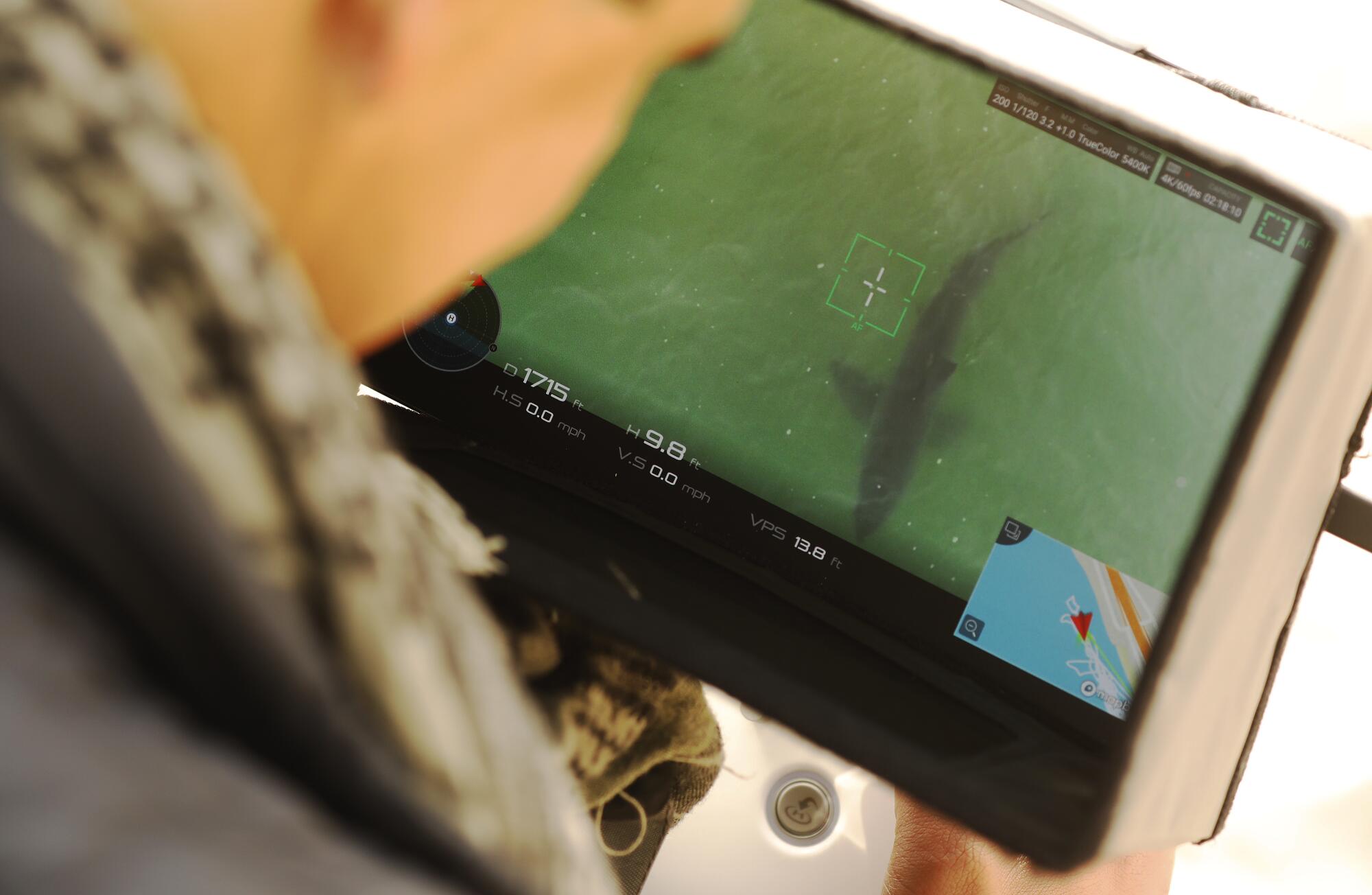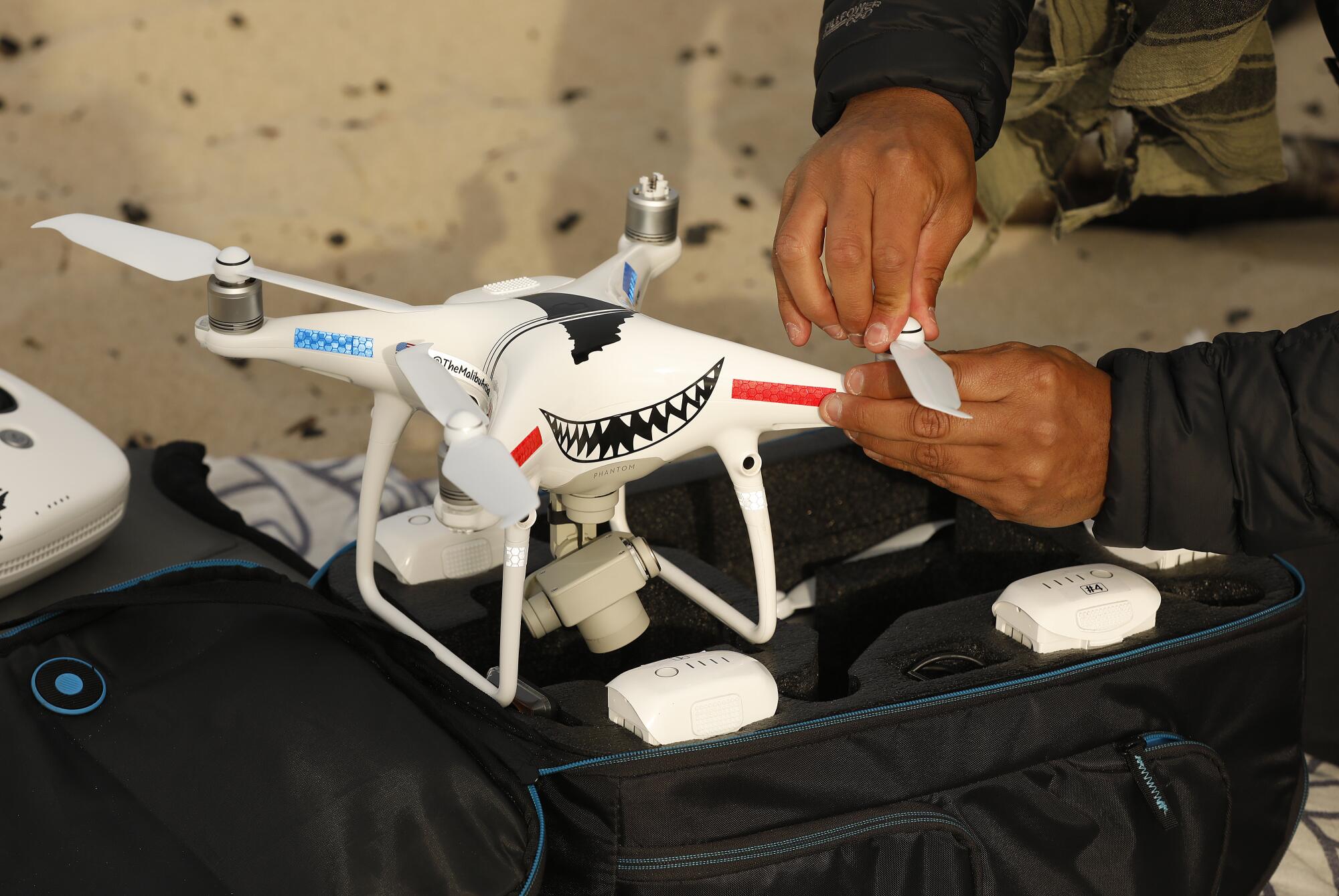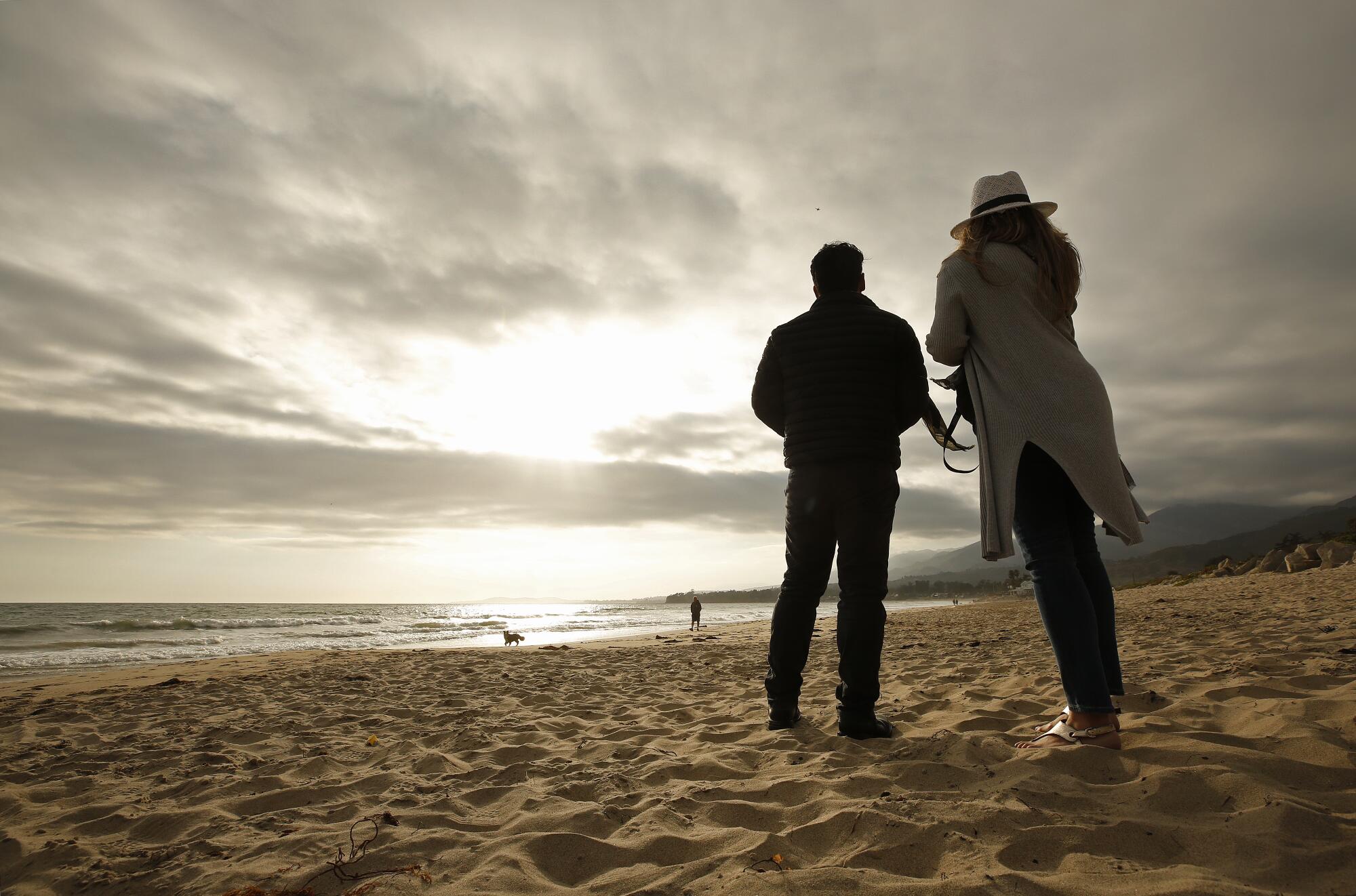- Share via
Carlos Gauna surveys the wind-blown waves off a popular Santa Barbara County beach. It is a cold, gray afternoon and only a few people are in the water: a father teaching his son to surf, a lone man wading in the whitewash.
Gauna launches his video drone, hoping to spy what might be moving stealthily among them — great white sharks.
In decades past, this might have seemed a quixotic venture. Great whites were thought to be somewhat rare in these southern waters, wandering now and then from the wilder coast up north. Most surfers considered it supremely improbable that one of these apex predators was hunting for food at their break.
The advent of drone photography has devoured that notion.

Gauna spots a great white within a minute-and-a-half of launch. The animal weaves languidly in the surf line, about 100 yards from the father and son. “Wow, he’s in the waves,” he says. “That is so pretty.”
Soon he has locked his screen on four more juvenile sharks, all near shore.
Gauna is not surprised. Unlike Police Chief Martin Brody in “Jaws,” he does not run screaming up the beach at everyone to get out of the water. The young sharks’ presence is normal. For much of the year, they are here, and not just at this beach, but along the entire coast from San Diego to Point Conception.
Humans just couldn’t see them until now.
“These types of encounters have always been happening,” he said. “Which shows you really just how low the number of attacks are.”
Gauna, through his YouTube channel, TheMalibuArtist, is part of a cadre of researchers and photographers using drones to study great white shark behavior and present them in a more realistic light than the hyped-up reality shows and horror movies.
Subscribers get early access to this story
We’re offering L.A. Times subscribers first access to our best journalism. Thank you for your support.
“Drones have become such a valuable tool for us scientists now,” says Christopher Lowe, a professor of marine biology and director of the Shark Lab at Cal State Long Beach. “It gives us that bird’s-eye view that we didn’t have before.”
“Carlos gets some awesome footage,” he adds. “He gets some spectacular stuff.”
For such a mythic predator, roaming most of the planet’s oceans, much of great white sharks’ lives remain a mystery. For instance, tagging has shown that California’s adults spend most of their lives in the middle of the Pacific, between Baja California and Hawaii — males for eight months a year, females for a year and a half at a time. No one knows why, or what they eat out there. But scientists are zeroing in on answers with more satellite tagging and aerial surveillance.
Lowe’s lab is conducting its own drone survey of the coast to find out what type of water user is most likely to encounter a shark and where.

“You got stand-up paddleboarders who are further away from the beach, you got surfers who are outside the break, you got waders and swimmers and they’re all in different places,” said Lowe. “We’re trying to find out where the sharks are spending their time.”
Researchers had long wondered how sharks, beyond the rare bites that make headlines, behave around people. Were they curious? Were they skittish? Or did they just ignore them?
“So far it looks like sharks just don’t care,” said Lowe.
“The surfers can’t see them, the swimmers can’t see them. But we can now see them from the air. And in those cases the sharks just don’t seem to change their path,” Lowe added. “Sometimes they’ll swim right under a surfer, but they don’t circle back. They just keep going.”

Lowe notifies lifeguards when he sees white sharks near people. The question now is what do the lifeguards do. They can’t close the beach every time a midsize juvenile shark shows up or the beaches would be closed constantly, especially in summer when the animals and people interact the most. The last fatal attack south of Point Conception occurred in Solana Beach in 2008, but there have been more than two dozen non-lethal incidents since then, with varying degrees of injuries.
Sharks have been around over 400 million years. Humans arrived around 300,000 years ago, and who knows when they started venturing into the sharks’ habitat. In evolutionary terms, we’re still novelties.
Sometimes the sharks do act curious about us newcomers, and given their potential for a probing lethal bite, those moments can be harrowing.
“Drones have become such a valuable tool for us scientists now. It gives us that bird’s eye view that we didn’t have before.”
— Christopher Lowe, a professor of marine biology and director of the Shark Lab at Cal State Long Beach
Gauna filmed two nerve-racking encounters on April 18 off this same beach in Santa Barbara County. First a 7-foot shark approached two young children floating just feet from the sand on bodyboards. He raced to them and motioned for them to come in. The shark turned away.
Ten minutes later he watched a larger one approach a surfer sitting on a 9-foot-2 longboard. The shark was as big as the board. The drone hovered directly above. But Guana was nearly a half mile away and could not warn him. The audio recording on his monitor captured his mounting anxiety.
“He’s turning toward the surfer,” Gauna said. “This surfer needs to look down, he has a shark right next to him. You got a shark right next to you, dude.”
Gauna has been trying to find a drone that could give an alert, but hasn’t found one compatible with the film equipment he uses.
The shark turned into the surfer under the nose of the board, as if it were going to start circling.
“Oh, my God, don’t bite him, don’t bite him, don’t bite him.”
That size of a shark is sub-adult, and usually just starting to upgrade their diet from stingrays and fish to harbor seals and other marine mammals. It could make a mistake. Just last year on this beach, a female swimmer was bitten on her foot and suffered two one-inch lacerations.
The shark slowly did a U-turn under the surfer and then kept swimming out to sea. The surfer never saw a thing.
::
“I learn something new about these animals just about every day I see them.”
— Carlos Gauna, drone photographer

Gauna took a circuitous route to wildlife photography. He was a child refugee of the war in El Salvador and grew up in remote Fort Sumner, N.M., population 1,031 — known mainly as the town where Pat Garrett shot and killed Billy the Kid.
He moved to Malibu after college to be near the ocean and earn a living as a wedding photographer. He bought a drone in 2015 and, on days off, shot whales migrating up and down the coast. He was astounded at the wildlife in the waters off a region with more than 20 million people.
“I filmed a blue whale — the largest animal on Earth — a mile off Point Dume.”
One day in July 2018, he saw a massive shark in his binoculars, but it was too windy to get his drone up. Just seeing the storied great white sparked his curiosity, and he started poring through a database of shark encounters to learn what beaches they most often frequented. He visited the spots and developed his eye to spot them.
“They just look like shadows at first.”
The pandemic shut his wedding business down, and he had more time to hunt sharks. In June 2020, he posted his first white shark video on YouTube, showing three whites methodically dismantling a dead dolphin just hundred or so yards off the coast. It got 2.8 million views.
He hasn’t looked back since then, devoting himself full time to the animals. He shoots with his wife, Andressa, who flies her own drone or keeps an eye on his if there are other aircraft in the area.

His videos can be almost hypnotic, tracing the shark’s languidly sinuous movement through the empty green. They meander through shoals of anchovies. They devour stingrays off the ocean floor.
Gauna comes to recognize individual animals by scars and patterns of crab-like parasites called copepods clinging to their back and fins. Lowe told Gauna he suspects the sharks might breach and land on their backs to get the itchy copepods off.
He watches as the younger ones learn how to hunt, through much trial and error. Harbor seals usually outmaneuver them, and can come behind them, bite them and chase them away.
“I learn something new about these animals just about every day I see them.”
In one video, Gauna captured a shark with a pectoral fin bent at a right angle from an injury, like a broken wing.
Phillip Sternes, a graduate student at UC Riverside, was fascinated when he saw it. Sternes was researching studying shark’s pectoral fins, trying to understand their purpose. “One of the great evolutionary novelties is the emergence of pectoral fins,” he said.
He said it’s not clear whether they use for lift in the water column or maneuverability or some other purpose. Gauna showed Sternes another video he took of the same shark, still alive five months later. It just sharpened the mystery.
“The shark is still healthy, not malnourished,” he said. “This does raise some serious questions regarding the function and purpose of the pectoral fin.”
::
The rise of drones coincided with strong evidence that the white shark population was rebounding after a long decline.
“We protected white sharks in 1994, we banned the use of gill-nets in near-shore waters,” Lowe said. “Marine mammals have recovered. And there is a climate change wrinkle in there. Southern California is probably becoming a better nursery because the water is getting warmer.”

Plus, in the last half-century, the stingray population boomed with most of their predators gone. Now the sharks are feasting on them.
“The round stingrays, we call them pancake rays because the young white sharks gobble them up like pancakes.”
While adult great whites move through Southern California waters, humans have driven off the massive pinniped rookeries that they once fed on. They mostly hunt the elephant seals and sea lions off the northern Channel Islands and Central California. The resurgent mammal populations there might even have attracted some great whites to stay all year long instead of going into the deep ocean. Either way, the grownups use the southern coast mostly as a nursery for their children.
Those juveniles can reach ten-feet long and still cause quite a start for the rare swimmer who actually sees one approach.
Every year, certain white shark nursery hot spots develop.

From 2009 to 2014, the young predators concentrated most in the Santa Monica Bay, Lowe’s lab found. The locus shifted the next three years to Huntington Beach and Long Beach. Then they moved to Dana Point in 2018 and 2019. And the last two years, they’ve been in northern San Diego County and southern Santa Barbara County.
Lowe and Gauna don’t like to divulge the exact locations because boat operators will converge there. Some chase them down, others operate tours, and chum the water to attract them.
“That is a problem,” Lowe said. “There are people swimming at those beaches and you’re training sharks to come to a floating object to get food.”
Gauna has watched tour boats race through the shallows, one running over at least four sharks.
“My sentiment is leave them alone,” he said. “Let sharks be sharks. If you have an encounter, give them space.
“They’ve always been here.”
More to Read
Sign up for Essential California
The most important California stories and recommendations in your inbox every morning.
You may occasionally receive promotional content from the Los Angeles Times.















